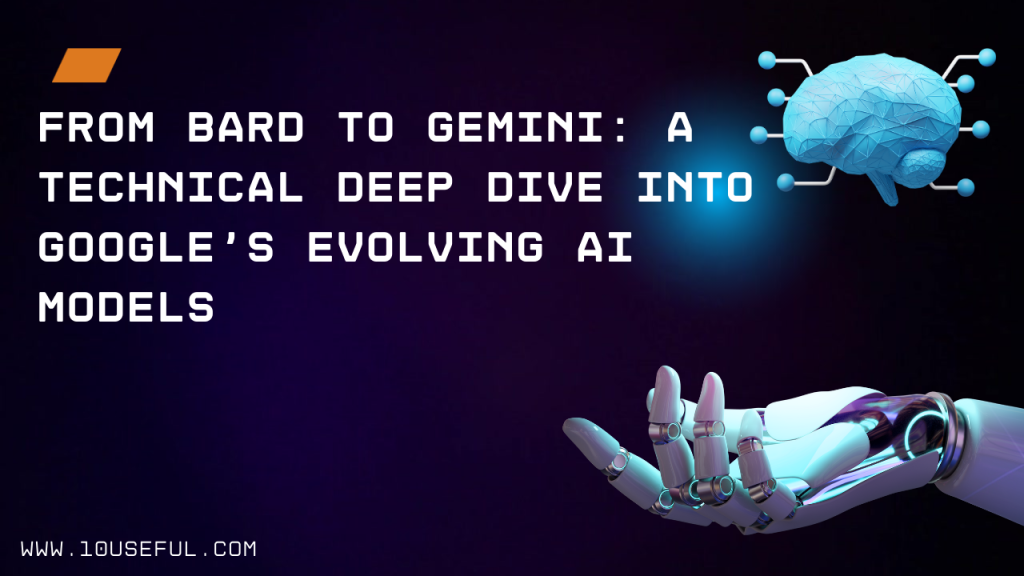The world of language models is constantly evolving, and Google stands at the forefront of this innovation. In 2022, the search giant introduced Bard, a large language model capable of generating text, translating languages, writing different kinds of creative content, and answering your questions in an informative way. However, in late 2023, Bard transitioned to become Gemini, marking a significant step in Google’s AI development. But what are the key differences between these two models, and how do they compare technically?
This article delves into the technical nuances of Bard and Gemini, exploring their core architecture, capabilities, and potential applications. We’ll use illustrative examples to showcase their strengths and weaknesses, providing a clear understanding of this exciting AI evolution.
Under the Hood: Exploring the Architecture
The differences between Bard and Gemini begin at their foundation – the underlying neural network architecture. Bard primarily relied on Recurrent Neural Networks (RNNs), a powerful tool for processing sequential data like text. RNNs excel at remembering contextual information and generating outputs based on prior inputs. However, they can struggle with long-range dependencies, meaning they might miss connections between elements further apart in a sequence.
Gemini, on the other hand, leverages transformers, a more advanced architecture that uses attention mechanisms. These mechanisms allow the model to focus on specific parts of the input sequence, enabling it to understand complex relationships and long-range dependencies within the data. This results in significantly improved performance on tasks requiring a deeper grasp of context and meaning.
Technical example: Consider the sentence “The man saw the dog and threw the ball.” An RNN might struggle to connect the ball-throwing action to the dog, as it processes the sentence sequentially. In contrast, a transformer can pay attention to both the dog and the ball simultaneously, leading to a more accurate understanding of the sentence’s meaning.
Expanding Capabilities: From Text to Multimodal Processing
One of the most significant advancements in Gemini is its ability to process and understand not just text, but also other modalities like code, images, and audio. This multimodality opens up a vast array of new possibilities, expanding beyond the text-centric capabilities of Bard.
Technical example: Imagine providing Gemini with an image of a cat and a sentence mentioning “playing fetch.” While Bard might struggle to connect the visual and textual information, Gemini can use its multimodal understanding to recognize the cat in the image and relate it to the action of playing fetch, leading to a more comprehensive interpretation of the combined data.
Diving Deeper: Enhanced Reasoning and Creativity
Beyond technical architecture, Gemini also boasts improvements in reasoning and creative abilities. Its advanced neural network allows for more complex logic and inference, enabling it to tackle challenging tasks involving problem-solving and argumentation. Additionally, Gemini can generate more creative text formats, including poems, scripts, musical pieces, and even code, demonstrating a deeper understanding of language and its different styles.
Technical example: Suppose you ask both Bard and Gemini to write a poem about a robot falling in love. Bard might generate a simple, rhyme-based poem. However, Gemini, with its enhanced reasoning and creative capabilities, could craft a more intricate poem exploring the robot’s emotions, motivations, and the unique challenges of its romantic quest.
Exploring the Applications: Where Do They Shine?
The differences in architecture, capabilities, and strengths translate into distinct application areas for Bard and Gemini.
Bard:
- Focus on text-based tasks: Generating different creative text formats (poems, code, scripts, musical pieces, etc.)
- Answering your questions in an informative way: Providing summaries of factual topics and research
- Conversational AI and effective customer communication: Acting as a chatbot or virtual assistant for simple interactions
Gemini:
- Content creation and SEO: Generating optimized, high-quality content for websites and marketing campaigns
- Complex tasks requiring deeper understanding: Coding, logical reasoning, argumentation, and problem-solving
- Multimodal interaction and analysis: Integrating information from text, images, code, and audio for richer insights
While Bard excels in tasks requiring basic text processing and generation, Gemini’s advanced capabilities make it better suited for scenarios demanding complex reasoning, multimodal understanding, and high-quality creative content generation.
Beyond the Differences: Looking Ahead
While Bard and Gemini represent significant milestones, the future of AI holds even more exciting possibilities. Here’s a deeper dive into potential advancements:
Neuromorphic Computing:
Stepping away from traditional silicon-based architectures, future models might adopt neuromorphic computing principles. This mimics the human brain’s structure and function, potentially leading to more efficient and natural language processing. Imagine systems that learn and adapt like children, acquiring real-world knowledge by interacting with the environment.
Unsupervised Learning:
Currently, large language models require vast amounts of labeled data for training. Unsupervised learning aims to break this dependence, allowing models to learn meaningful representations from raw data without explicit labels. This unlocks the potential for truly self-learning systems, constantly evolving and expanding their knowledge without human intervention. Think of machines reading entire libraries and extracting unique insights without needing someone to categorize every sentence.
Explainable AI:
As AI models become more complex, understanding their decision-making processes becomes crucial. Explainable AI aims to make these models transparent, revealing the reasoning behind their outputs. This fosters trust and facilitates collaboration between humans and AI, ensuring ethical and responsible use of technology. Imagine explaining a model’s creative process for writing a poem or its logic behind solving a complex problem.
Beyond Language:
While Bard and Gemini focus on text, the future might see multi-modal models excel in various domains. Imagine AI systems that not only understand language but can also process and integrate information from other modalities like vision, sound, and touch. Think of machines composing music while understanding its emotional impact, or analyzing scientific data across text, images, and simulations.
Societal Impact:
The advancements in AI language models pose exciting opportunities and challenges. From personalized education and healthcare to automated creative industries and scientific discoveries, the potential applications are vast. However, ethical considerations like bias, fairness, and data privacy need careful attention. Responsible development and open dialogue are key to ensuring AI benefits all of humanity.
In conclusion, Bard and Gemini mark significant steps in Google’s AI journey, each highlighting unique strengths and paving the way for future advancements. With the exciting developments in neuromorphic computing, unsupervised learning, explainable AI, and multi-modal processing, the future of language models promises to be transformative, impacting every aspect of our lives in remarkable ways. As we navigate this evolving landscape, let’s strive to utilize these powerful tools ethically and responsibly, ensuring that AI works for the greater good.

